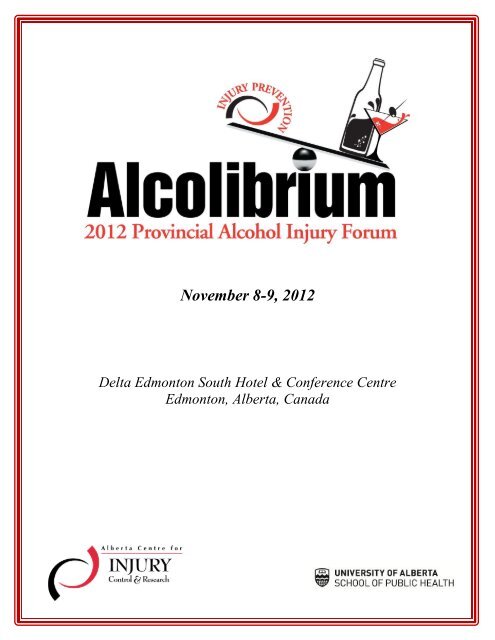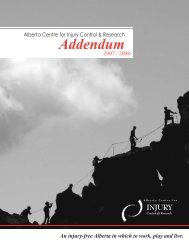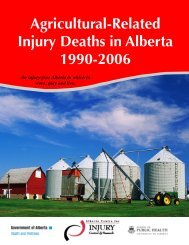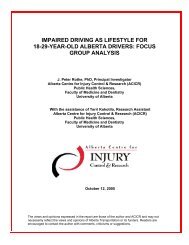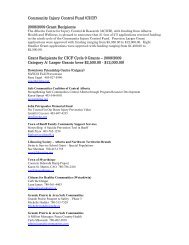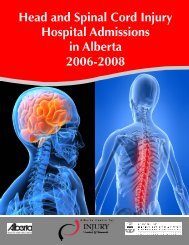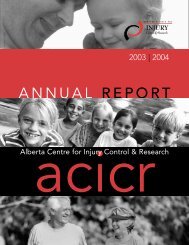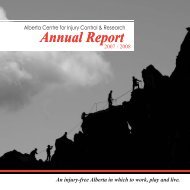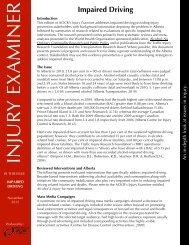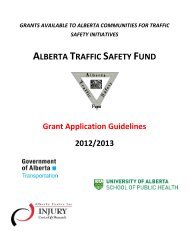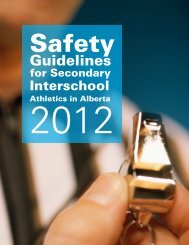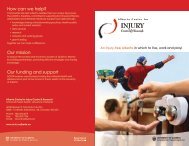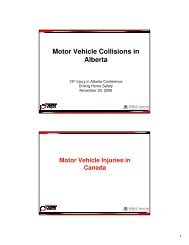Delegates Program - Alberta Centre for Injury Control & Research
Delegates Program - Alberta Centre for Injury Control & Research
Delegates Program - Alberta Centre for Injury Control & Research
You also want an ePaper? Increase the reach of your titles
YUMPU automatically turns print PDFs into web optimized ePapers that Google loves.
November 8-9, 2012<br />
Delta Edmonton South Hotel & Conference <strong>Centre</strong><br />
Edmonton, <strong>Alberta</strong>, Canada
Forum Agenda<br />
Forum Registration:<br />
November 8<br />
November 9<br />
7:00 – 9:00 AM<br />
7:30 – 9:00 AM<br />
November 8<br />
7:30 - 8:30 Breakfast<br />
8:30 - 8:45 Welcome address - Kathy Belton, Associate Director, <strong>Alberta</strong> <strong>Centre</strong> <strong>for</strong><br />
<strong>Injury</strong> <strong>Control</strong> & <strong>Research</strong> (ACICR)<br />
8:45 - 10:00<br />
Alcohol Use and <strong>Injury</strong> in <strong>Alberta</strong><br />
Keynote speaker, Dr. Don Voaklander will focus on what we know about alcohol and injury in<br />
<strong>Alberta</strong> discussing both intentional violence and unintentional injury. His presentation will focus<br />
on data derived from the Office of the Provincial Medical Examiner and the <strong>Alberta</strong> Trauma<br />
Registry. Keynote speaker, Dr. Cam Wild will present his research on alcohol-related behaviours<br />
and attitudes. Intervention opportunities in a variety of <strong>Alberta</strong> populations will also be presented.<br />
10:00 - 10:15 Break<br />
10:15 - 11:15<br />
The Ecology of Alcohol Use: Individual Choices and Community Safety<br />
Keynote speaker, Dr. James Talbot will highlight how alcohol use affects individuals by<br />
increasing their risk of injury and will examine the conflict between an individual's right to<br />
choose to over consume alcohol and the right of communities to be safe and free of injury.<br />
11:15 - 11:45<br />
<strong>Research</strong> to reality: how alcohol impacts <strong>Alberta</strong>ns<br />
Participants’ stories will illustrate the relationship between alcohol and injury/ safety and how<br />
harmful alcohol use affects a wide variety of <strong>Alberta</strong>ns in many settings.<br />
Trauma nurse<br />
Paramedic<br />
Firefighter<br />
Police officer<br />
Sexual assault counsellor<br />
Liquor store clerk<br />
Page 1 of 37
Liquor server<br />
Survivor<br />
11:45 - 12:45 Lunch<br />
12:45 - 4:15<br />
<strong>Alberta</strong> Initiatives Showcase<br />
Panelists from urban and rural communities will showcase their initiative that addresses various<br />
alcohol-related issues utilizing education, policy and/or en<strong>for</strong>cement methods.<br />
Limited time will be provided <strong>for</strong> <strong>for</strong>um delegates to ask questions about the initiatives presented.<br />
The delegates’ program includes a summary of each initiative along with contact in<strong>for</strong>mation <strong>for</strong><br />
future follow-up.<br />
12:45 - 1:30<br />
Youth/Young Adult Initiatives<br />
Don’t Be That Guy Campaign: A poster campaign which addresses alcohol-facilitated<br />
sexual assault without victim-blaming is presented<br />
Check Yourself: This presentation summarizes the experience of a University of <strong>Alberta</strong><br />
coalition that implemented a brief, personalized normative feedback tool designed to<br />
reduce alcohol consumption among problem drinkers<br />
Parents Connect: This project used a positive norms approach to facilitate parental<br />
monitoring, family connections and clear rules and expectations to prevent harmful use of<br />
substances and associated risk taking behaviour<br />
1:30 - 2:45<br />
Municipal Initiatives<br />
Public Safety Compliance Team: Utilizing a multidisciplinary regulatory team that works<br />
with licensed establishments to increase safety, best practices and compliance with<br />
municipal, provincial and federal legislation<br />
Business Hours Bylaw in Wetaskiwin: RCMP and hospital records are presented and<br />
compared to a control community to determine the impact of a bylaw which reduces local<br />
liquor vendors’ operation hours<br />
Night Ride: Piloting a late-night bus, using public transit, to provide a quick and safe late<br />
night transportation option and reduce taxi wait times <strong>for</strong> employees and patrons in the<br />
area<br />
1=What?: Educating consumers and merchants about standard drink equivalencies and<br />
associated risks in high alcohol content and volume beverages<br />
2:45 - 3:00 Break<br />
Page 2 of 37
3:00 - 4:15<br />
Organizational Initiatives<br />
BRIEF Interventions: Developing a frontline approach to increase admitted trauma<br />
patients’ awareness of risky drinking or drug use and explore options to change<br />
behaviour<br />
In-Roads Project: A description is provided of a mentorship project where addictions<br />
counsellors work with crisis services staff to more effectively screen and address highrisk<br />
alcohol use with their clients<br />
Best Bar None: An owner of clubs/bars will present policies and procedures that reduce<br />
alcohol-related harms in and around his licensed premises<br />
Shifting to Wellness: utilizing an educational tool focusing on shiftwork and wellness<br />
in the workplace to address alcohol use<br />
DrinkSMARTS: Promoting Canada’s Low Risk Drinking Guidelines with young adults in<br />
workplaces and in the community to address high risk drinking<br />
4:15 - 4:30 Closing Remarks – Dr. Don Voaklander, Director, ACICR<br />
4:30 - 5:30<br />
Meet and Greet (mocktail, soft drinks, cash bar and cheese service)<br />
Page 3 of 37
November 9<br />
7:30 - 8:30 Breakfast<br />
8:30 - 8:45<br />
Day 2 opening remarks – Don Voaklander, Director, ACICR<br />
8:45 - 9:45<br />
<strong>Alberta</strong> Alcohol Strategy – Shannon McInnes, <strong>Alberta</strong> Health and Shiela Bradley , <strong>Alberta</strong><br />
Health Services<br />
Why was it developed<br />
Process of development<br />
Description of the strategy - outcomes, key themes, strategic priorities and recommended<br />
actions<br />
Current status<br />
Kim Ghostkeeper, <strong>Alberta</strong> Culture Community Services<br />
How does the <strong>Alberta</strong> Alcohol Strategy support alcohol-related injury prevention?<br />
9:45 - 10:00 Break<br />
10:00 - 12:00<br />
Identifying actions to reduce alcohol-related injury – Part I<br />
Kim Ghostkeeper, <strong>Alberta</strong> Culture Community Services<br />
You will play a part in reducing alcohol-related injuries. You and other <strong>for</strong>um participants will<br />
guide future work on this important issue. Take an active role in the professionally facilitated<br />
working groups as the knowledge, expertise and experiences of all <strong>for</strong>um attendees are brought<br />
together to answer:<br />
What do we need to do together to move the work of alcohol-related injury prevention<br />
<strong>for</strong>ward in <strong>Alberta</strong> over the next 1-3 years?<br />
12:00 - 12:45 Lunch<br />
Page 4 of 37
12:45 - 3:00<br />
Identifying actions to reduce alcohol-related injury and move injury-related components of<br />
the <strong>Alberta</strong> Alcohol Strategy <strong>for</strong>ward – Part II<br />
Kim Ghostkeeper, <strong>Alberta</strong> Culture Community Services<br />
<br />
<br />
<br />
Who will lead?<br />
Resources required?<br />
What does success look like in the:<br />
Short term?<br />
Long term ?<br />
3:00 - 3:15 Closing Remarks – Kathy Belton, Associate Director, ACICR<br />
Page 5 of 37
<strong>Alberta</strong> Initiatives Showcase<br />
Don’t Be That Guy Campaign:<br />
A poster campaign which addresses alcohol-facilitated sexual assault without victim-blaming is<br />
presented.<br />
Speaker:<br />
Karen Smith, Executive Director<br />
Sexual Assault <strong>Centre</strong> of Edmonton<br />
What was the actual and/or potential alcohol-related injury issue(s) you identified in your<br />
community?<br />
Significant increase in the number of alcohol-facilitated sexual assaults reported to<br />
Edmonton Police Service<br />
Offenders were almost exclusively young men between 18 and 25 years of age<br />
Victims were young women of a similar age<br />
Recognition that “tips” provided to young women are not only useless – they actually<br />
rein<strong>for</strong>ce the myths in our communities about sexual violence<br />
What did you do to address the identified issue(s)?<br />
Community collaboration to develop a poster campaign addressing this issue targeted at<br />
offenders NOT victims<br />
What outcomes did you observe?<br />
World-wide attention shows that this is a significant problem<br />
Over 50% of young men believe that if a young woman has passed out from intoxication,<br />
it is acceptable to sexually assault her<br />
Lack of awareness of Canadian legislation regarding consent laws and sexual assault<br />
Young men understood the message we were conveying in posters<br />
How might other <strong>Alberta</strong> communities use this in<strong>for</strong>mation?<br />
Camera ready posters are available FREE of charge to anyone in the world who requests<br />
them<br />
Recognition that this is a real and significant problem in ALL <strong>Alberta</strong> communities<br />
Contact:<br />
Karen Smith<br />
780-423-4102<br />
smith.karen@sace.ab.ca<br />
Page 6 of 37
Check Yourself:<br />
This presentation summarizes the experience of a University of <strong>Alberta</strong> coalition that<br />
implemented a brief, personalized normative feedback tool designed to reduce alcohol<br />
consumption among problem drinkers.<br />
Speaker:<br />
Dr. Cam Wild, Professor and Associate Dean<br />
School of Public Health, University of <strong>Alberta</strong><br />
What was the actual and/or potential alcohol-related injury issue(s) you identified in your<br />
community?<br />
Problem drinking among young adults is associated with an increased risk of a variety of<br />
acute intoxication-related injuries and harms, including alcohol poisoning, minor or<br />
major bodily trauma, injuries resulting from interpersonal violence, and vehicular<br />
accidents as a result of driving while intoxicated<br />
What did you do to address the identified issue(s)?<br />
A brief online personalized assessment-feedback intervention tool was customized <strong>for</strong> the<br />
University of <strong>Alberta</strong> student population. A coalition of representatives of University<br />
units concerned about the harms associated with problem drinking among students<br />
worked together to offer the tool marketed as Check Yourself. It was made available<br />
using a variety of marketing strategies as a universal population-level intervention as well<br />
as in targeted situations to students demonstrating signs of problem drinking<br />
What outcomes did you observe?<br />
As expected, and consistent with studies evaluating the efficacy of this intervention, the<br />
Check Yourself tool tended to be appeal to students who showed signs of problem<br />
drinking. Use of the tool was highest when sending personalized email invitations to<br />
students and offering a small monetary incentive<br />
How might other <strong>Alberta</strong> communities use this in<strong>for</strong>mation?<br />
This research demonstrates the utility of a population-based brief intervention <strong>for</strong><br />
reducing problem drinking and offers insight into the relative effectiveness of low cost<br />
methods of marketing and disseminating the tool<br />
Contact:<br />
Cam Wild<br />
780-492-6752<br />
cam.wild@ualberta.ca<br />
Page 7 of 37
Parents Connect:<br />
This project used a positive norms approach to facilitate parental monitoring, family connections<br />
and clear rules and expectations to prevent harmful use of substances and associated risk taking<br />
behavior.<br />
Speaker:<br />
Stacie Pederson, Health Promotion<br />
<strong>Alberta</strong> Health Services, Central Zone<br />
What was the actual and/or potential alcohol-related injury issue(s) you identified in your<br />
community?<br />
Substance use is a concern among Stettler residents as shown through many discussions<br />
among professionals, media reports and parental enquiries<br />
The AADAC <strong>Alberta</strong> Youth Experience Survey (2005) shows that binge drinking<br />
increases significantly with age: 3.0% of students in grade 7 and 47.5% of students in<br />
grade 12<br />
The AADAC <strong>Alberta</strong> Youth Experience Survey (2005) shows that hazardous drinking<br />
increases by age: 5.9% of grade 7 students and 39.9% of grade 12 students<br />
Potential alcohol-related injuries include impaired driving, violence, poisoning and falls<br />
What did you do to address the identified issue(s)?<br />
Parents Connect was developed in light of research where youth identified parental<br />
monitoring and supervision as the most important protective factor in keeping them drug<br />
and alcohol free. Reducing risk taking and subsequent injuries through parental<br />
monitoring was also factored into the project due to the correlation between substance<br />
use and injuries<br />
Parents Connect began by focusing on a social marketing campaign aimed at parents of<br />
middle and high school youth. Three main messages were developed and marketed along<br />
Hwy 12 at venues where families gathered and through local media outlets. Marketing<br />
consisted of restaurant place mats (in<strong>for</strong>mation and activities included), community tool<br />
kits, posters, press releases, displays and local newspaper and school newsletter articles.<br />
The messages included: “I have friends. Only you can be my parent”; “Connected<br />
parents. The real superheroes in the fight to stop drugs”; “Your kids don’t have to go<br />
behind your back when you do stuff side by side.” All three messages were supported by<br />
the tagline, “ Parents Ask. Parents Care. Parents Connect.”<br />
Phase two of Parents Connect focused on a social norms campaign focusing on<br />
promoting positive peer pressure to both youth and parents that parental monitoring and<br />
supervision is the norm and that youth do want to spend time with their family. A social<br />
norms survey was conducted and marketing materials and weekly articles were used to<br />
promote the findings and messages<br />
Page 8 of 37
What outcomes did you observe?<br />
Phase 1<br />
o 1/3 of surveyed parents were aware of the Parents Connect campaign<br />
o Those who were aware of the program identified the following as areas they<br />
learned more about as a result of the campaign: communication with my<br />
children (41%); time with family (37%); and parental monitoring (30%)<br />
o 78% of those who were aware of the campaign believed it made a difference in<br />
supporting their parental role<br />
Phase 2 Social norms survey results<br />
o Nine out of 10 students say: “When I’m not home my parents know where I am<br />
and who I am with”<br />
o Nine out of 10 students say: “My parents want me to call if I’m going to be late”<br />
o Nine out of 10 students report their family “has clear rules about alcohol and<br />
drug use”<br />
o Nine out of 10 students say their family “has clear rules about school attendance”<br />
o Eight out of 10 students say their family “has clear rules about household chores”<br />
Note: The evaluation plan <strong>for</strong> phase two, the social norms campaign, was not finalized as half of<br />
the committee members moved from the area reducing the manpower of the project significantly.<br />
However, the evaluation plan as it was intended can be shared.<br />
How might other <strong>Alberta</strong> communities use this in<strong>for</strong>mation?<br />
<strong>Alberta</strong> communities seeking ideas to prevent substance use through a positive family<br />
and community relationships based approach, and consequently reduce<br />
intentional/unintentional injuries associated with their use, could adapt and adopt the<br />
materials developed by the Parents Connect project. This could include but is not is not<br />
limited to, background research, marketing materials, social norms questions, place mat<br />
design and resources. Two of the committee members remain in Stettler and could<br />
provide in<strong>for</strong>mation upon request<br />
Contact: Stacie Pederson<br />
403-740-7315<br />
Stacie.Pederson@albertahealthservices.ca<br />
Page 9 of 37
Public Safety Compliance Team:<br />
Utilizing a multidisciplinary regulatory team that works with licensed establishments to increase<br />
safety, best practices and compliance with municipal, provincial and federal legislation<br />
Speaker:<br />
Sgt. Nicole Chapdelaine<br />
Past Public Safety Compliance Team Coordinator (P.S.C.T.)<br />
D.E.O.P.S. / Responsible Hospitality Edmonton<br />
What was the actual and/or potential alcohol-related injury issue(s) you identified in your<br />
community?<br />
Violence in and around licensed establishments<br />
What did you do to address the identified issue(s)?<br />
The PSCT is the regulatory and en<strong>for</strong>cement arm of the City of Edmonton's Responsible<br />
Hospitality Edmonton initiative. It consists of support and participation by the Edmonton<br />
Police Service, Edmonton Fire Safety, City of Edmonton Community Standards Branch,<br />
and the <strong>Alberta</strong> Gaming and Liquor Commission<br />
The PSCT was established to improve the City of Edmonton’s commitment in dealing<br />
with premises, venues and events that exist to cater to the demands of the hospitality<br />
industry; commonly known as bars, nightclubs, venues, events and after-hours clubs<br />
The PSCT utilizes education, prevention and en<strong>for</strong>cement specific to existing municipal,<br />
provincial and federal legislation as well as industry best practices to increase compliance<br />
What outcomes did you observe?<br />
A decrease in violence in and around licensed establishments<br />
An increase in compliance on existing legislation from licensed establishments<br />
Eventual closure, sale or re-brand of non-compliant licensed establishments<br />
Change to the City of Edmonton's Business License Bylaw to allow <strong>for</strong> better<br />
consultation on the appropriateness of the issuance of business license to an Alcohol<br />
Sales [Consumption on Premises/Minors Prohibited] within the City of Edmonton<br />
The use of scanning systems within liquor licensed establishments within the City to<br />
Edmonton to assist in the reduction of alcohol related harms<br />
A Guide to Community Hall Rentals, a resource to assist Community Halls with<br />
in<strong>for</strong>mation to improve rental practices and reduce the risk of a bad rental.<br />
How might other <strong>Alberta</strong> communities use this in<strong>for</strong>mation?<br />
Creation of similar multi-disciplinary team approach to work with licensed<br />
establishments in their community<br />
Contact:<br />
Jacob Montgomery or Nicole Chapdelaine<br />
780-421-2832 PSCT Coordinator Desk<br />
jacob.montgomery@edmontonpolice.ca or nicole.chapdelaine@edmontonpolice.ca<br />
Page 10 of 37
Business Hours Bylaw in Wetaskiwin:<br />
RCMP and hospital records are presented and compared to a control community to determine the<br />
impact of a bylaw which reduces local liquor vendors’ operation hours<br />
Speaker:<br />
Dr. Don Voaklander, Director<br />
<strong>Alberta</strong> <strong>Centre</strong> <strong>for</strong> <strong>Injury</strong> <strong>Control</strong> & <strong>Research</strong><br />
What was the actual and/or potential alcohol-related injury issue(s) you identified in your<br />
community?<br />
City Council in Wetaskiwin, with public and en<strong>for</strong>cement support felt that the availability<br />
of liquor was negatively affecting the quality of life in Wetaskiwin<br />
What did you do to address the identified issue(s)?<br />
On January 1, 2009 a bylaw came in to <strong>for</strong>ce where liquor stores and alcohol off sales<br />
would not be allowed after 10:00 P.M. in the evening<br />
What outcomes did you observe?<br />
Data from RCMP records examining trends in en<strong>for</strong>cement statistics be<strong>for</strong>e and after the<br />
bylaw was instituted did not exhibit any significant effect of the bylaw. An examination<br />
of Emergency Department (ED) records revealed a reduction in injury presentations postlegislation.<br />
This included a reduction in the proportion of injuries reported as assaults<br />
and self-harm<br />
How might other <strong>Alberta</strong> communities use this in<strong>for</strong>mation?<br />
Other communities where there is a problem with drinking related injury may use similar<br />
legislation to control alcohol problems in their community<br />
Contact:<br />
Don Voaklander<br />
780 492 0454<br />
don.voaklander@ualberta.ca<br />
Page 11 of 37
Night Ride:<br />
Piloting a late-night bus, using public transit, to provide a quick and safe late night transportation<br />
option and reduce taxi wait times <strong>for</strong> employees and patrons in the area.<br />
Speaker:<br />
Cindy Davies, Street-as-a-Venue Coordinator<br />
Whyte Avenue, Responsible Hospitality Edmonton, Sustainable Development City<br />
of Edmonton<br />
What was the actual and/or potential alcohol-related injury issue(s) you identified in your<br />
community?<br />
As noted in many cities, there is a lack of late night transportation options at closing time<br />
of licensed venues, particularly on weekends. This creates a competitive environment<br />
where impatience, frustration and discom<strong>for</strong>t can lead to anti-social behaviour;<br />
congestion on sidewalks can lead to aggression and violence, and patrons are exposed to<br />
increased risk <strong>for</strong> pedestrian-vehicle collisions in ef<strong>for</strong>ts to secure a ride. Community<br />
neighbours are disturbed<br />
What did you do to address the identified issue(s)?<br />
Trialed a late night public transit project that had buses run every 12 minutes on a circular<br />
route through the Whyte Avenue entertainment district, to University residences, through<br />
student populated communities and to a Taxi Stand from which patrons could take a cab<br />
to further destinations<br />
What outcomes did you observe?<br />
Late night patrons want to go home - the major complaint was the trial should have been<br />
more extensive to include more areas of the city<br />
Bus riders were pleased with an option of a warm, safe, low-cost ride that allowed them<br />
to leave the area. 70% of riders disembarked along the route. Those who used the Taxi<br />
stand stated the bus ride was preferable to competing <strong>for</strong> a cab on Whyte, as cabs were<br />
available within minutes<br />
There were no incidents of note at bus stops, on the bus, at the Taxi stand, in taxis or in<br />
communities along the route. There was only one “sick bus”. Numbers were not high<br />
enough to ascribe any definitive reductions in Police activity<br />
Taxi drivers used the taxi stand as it reduced their unpaid return time by 30 blocks and<br />
they avoided the risks of pedestrian collisions created by people wanting a cab running<br />
into the street on Whyte<br />
How might other <strong>Alberta</strong> communities use this in<strong>for</strong>mation?<br />
By identifying the magnitude of the gap between available transportation and the<br />
numbers of patrons who have chosen to not drink and drive, communities begin to<br />
understand the impacts created by this gap (litter, noise, public urination, vandalism and<br />
Page 12 of 37
violence) and can explore a variety of program/infrastructure and transportation options.<br />
Use of a bus would be an acceptable option<br />
Contact:<br />
Cindy Davies<br />
780 495-0388 or 780 914-6657<br />
cindy.davies@edmonton.ca<br />
Page 13 of 37
1=What?:<br />
Educating consumers and merchants about standard drink equivalencies and associated risks in<br />
high alcohol content and volume beverages<br />
Speaker:<br />
Kris Andreychuk, Social Work Supervisor<br />
City of Edmonton, Community Services<br />
Neighbourhood Empowerment Team (NET)<br />
What was the actual and/or potential alcohol-related injury issue(s) you identified in your<br />
community?<br />
Violence and social disorder<br />
High percentage, large volume single serve products contribute to violence (primarily<br />
victimization)<br />
What did you do to address the identified issue(s)?<br />
Engaged in face-to-face interviews and interactions with over 160 McCauley community<br />
members consuming alcohol in public and found that inexpensive, high alcohol and large<br />
servings alcohol products posed a significant problem<br />
An education campaign was developed to increase awareness of alcohol content in single<br />
serve products. ‘1 = What?’ campaign in<strong>for</strong>ms vendors and consumers about standard<br />
drink content using posters, window clings and handbills displayed in neighbourhood<br />
liquor stores. An example of a message is: a 40oz bottle at 10.1% alcohol is equivalent to<br />
7 standard drinks or ‘1=7’<br />
What outcomes did you observe?<br />
In<strong>for</strong>mation is available to merchants, consumers and the public at large to make better<br />
in<strong>for</strong>med decisions concerning what they’re selling and consuming<br />
Three of the four liquor stores in McCauley are voluntarily participating in the campaign.<br />
The merchants recognize the issues associated with over-service/consumption and have<br />
stated that they want to work with NET to make McCauley a safer neighbourhood<br />
This project will be evaluated through Edmonton Police Service statistics and overservice<br />
en<strong>for</strong>cement in 2012<br />
How might other <strong>Alberta</strong> communities use this in<strong>for</strong>mation?<br />
The conversion to ‘Standard Units of Alcohol’ is universally applicable and can be<br />
applied in many other communities and businesses<br />
Contact:<br />
Kris Andreychuk<br />
780-944-8402<br />
kris.andreychuk@edmontonpolice.ca<br />
http://www.trans<strong>for</strong>mingedmonton.ca/index.php/author/kris-andreychuk/<br />
Page 14 of 37
BRIEF Interventions:<br />
Developing a frontline approach to increase admitted trauma patients’ awareness of risky<br />
drinking or drug use and explore options to change behaviour.<br />
Speaker:<br />
Christine Vis, BSN, RN, Manager<br />
Trauma Services and Unit 44 Trauma/Surgery<br />
Foothills Medical <strong>Centre</strong><br />
<strong>Alberta</strong> Health Services<br />
What was the actual and/or potential alcohol-related injury issue(s) you identified in your<br />
community?<br />
Statistics show that approximately 50% of all trauma patients admitted to Trauma Centers<br />
have positive blood alcohol levels (BAL). Most of the alcohol-related injuries do not<br />
involve alcohol dependant people but moderate or at-risk drinkers who may not know<br />
how much they can safely drink<br />
As an accredited Level 1 trauma centre and an inpatient trauma unit, front line workers<br />
care <strong>for</strong> patients who have had alcohol-related injury. In 2011-2012, of the 565 admitted<br />
patients tested <strong>for</strong> blood alcohol, 32.4% tested positive (above 0.08% blood alcohol<br />
concentration)<br />
What did you do to address the identified issue(s)?<br />
The Trauma Association of Canada Accreditation guidelines recommend that Level I and<br />
II Trauma <strong>Centre</strong>s should screen <strong>for</strong> problem drinking and substance abuse and offer a<br />
brief intervention. The guidelines also recommend that appropriate interventions be<br />
available to minimize recidivistic high-risk behavior<br />
Through the Patient Care In<strong>for</strong>mation System (SCM), blood alcohol screening and urine<br />
drug screening has become a part of the trauma admission panel. Screening on admission<br />
to the unit will also take place<br />
A front line approach is being developed where nurses will deliver BRIEF Interventions<br />
to patients. A team of nurses and allied health professionals who work on the unit have<br />
volunteered to receive training and deliver the BRIEF Intervention to patients. Additional<br />
referral and follow-up will be offered to patients upon request<br />
Material <strong>for</strong> patient and family in<strong>for</strong>mation has been developed<br />
Tracking intervention numbers and measuring patients’ perceptions of the BRIEF<br />
Interventions are also part of the initial phase of the project<br />
What outcomes did you observe?<br />
This project is currently in the initiation phase of policy and program development.<br />
Implementation is just occurring<br />
Future plans <strong>for</strong> screening through site specific trauma registry indicators are in the<br />
works so public reporting of our intervention strategy and its impact will be done<br />
Page 15 of 37
Screening and Brief Intervention raises patients’ awareness of at-risk drinking or drug use<br />
and provides patients with an opportunity to explore options to change their risk<br />
behaviour<br />
Other research shows that approaching patients and offering Brief Intervention during the<br />
“teachable moment” of their trauma admission helps reduce future admissions by as<br />
much as 50%<br />
How might other <strong>Alberta</strong> communities use this in<strong>for</strong>mation?<br />
This unit policy has been developed with the intent of sharing with any other AHS<br />
inpatient units/programs interested in implementing a frontline approach to this public<br />
health concern<br />
Contact:<br />
Christine Vis<br />
403-944-4339<br />
chris.vis@albertahealthservices.ca<br />
Carol Willoughby<br />
carol.willoughby@albertahealthservices.ca<br />
Page 16 of 37
In-Roads Project:<br />
A description is provided of a mentorship project where addictions counsellors work with crisis<br />
services staff to more effectively screen and address high-risk alcohol use with their clients.<br />
Speakers:<br />
Nancy McCalder, Executive Director<br />
The Support Network<br />
Denise Salanski, <strong>Program</strong> Consultant<br />
In-Roads <strong>Program</strong>, Addiction and Mental Health<br />
<strong>Alberta</strong> Health Services<br />
<strong>Program</strong>s Description:<br />
In-Roads is designed to improve access to screening, assessment, referral and early<br />
intervention treatment services <strong>for</strong> youth and young adults that are at risk <strong>for</strong> substance<br />
abuse problems. It is delivered in partnership with community organizations with the<br />
outcome that youth and young adults receive, at minimum, an initial addiction assessment<br />
and intervention at youth and young adult serving facilities or programs that they utilize.<br />
The Support Network offers telephone, on-line and in-person support to people requiring<br />
in<strong>for</strong>mation and referral, crisis support and short term solution focussed counselling.<br />
Services include: 211 Edmonton- In<strong>for</strong>mation and Referral, Distress Line, On-Line Crisis<br />
Chat, Suicide Bereavement and Caregiver Support, Educations Services, and Walk-In<br />
Counselling.<br />
What was the actual and/or potential alcohol-related injury issue(s) you identified in your<br />
community?<br />
<strong>Alberta</strong> Health Services - Addiction and Mental Health identified a need <strong>for</strong> at-risk youth<br />
and young adults aged 12 to 24 years age. Clients encountered difficulties navigating<br />
through the complicated and diverse systems to receive addiction treatment. This<br />
decreased the likelihood of their follow-through and engagement in the treatment process.<br />
The need <strong>for</strong> an increased collaborative and multi-sector approach to treatment to ensure<br />
a full continuum of accessible and available services was developed<br />
In 2011, over 750 callers to the Distress Line identified addictions as their main reason<br />
<strong>for</strong> reaching out <strong>for</strong> mental health and suicide prevention support. Training staff and<br />
volunteers to screen and intervene with clients who identify or present with substance<br />
abuse issues was needed. In-Roads was seen as an opportunity to raise the knowledge<br />
and skill level in substance abuse issues of staff in order to address the complexity of<br />
calls or client cases that are seeking support from The Support Network<br />
What did you do to address the identified issue(s)?<br />
AHS-In-Roads and The Support Network entered into a contractual agreement to<br />
enhance the substance abuse related competencies of service providers who serve at-risk<br />
Page 17 of 37
youth and young adults. An intensive mentoring program provides service providers an<br />
opportunity to increase their knowledge and skills on substance abuse screening,<br />
assessment, referral and early intervention<br />
What outcomes did you observe?<br />
Increased collaboration between AHS Addiction and Mental Health and The Support<br />
Network<br />
Service providers increased their knowledge and skills regarding substance abuse,<br />
awareness of early intervention and treatment options <strong>for</strong> clients, engagement and referral<br />
of at-risk youth and young adults who experience substance abuse problems<br />
Development and use of agency friendly tools to screen <strong>for</strong> substance abuse related issues<br />
How might other <strong>Alberta</strong> communities use this in<strong>for</strong>mation?<br />
Utilizing a mentoring and curriculum based training model, other communities can begin<br />
to meet the needs of clients who are at-risk of or entrenched in a life of substance abuse<br />
Contact:<br />
Nancy McCalder<br />
780-732-6635<br />
nmccalder@thesupportnetwork.com<br />
Denise Salanski<br />
780-638-4170<br />
denise.salanski@albertahealthservices.ca<br />
Page 18 of 37
Best Bar None:<br />
An owner of clubs/bars will present policies and procedures that reduce alcohol-related harms in<br />
and around his licensed premises.<br />
Speaker:<br />
Jesse Kupina, Owner<br />
Two 12 Social Co. (Union Hall, The Ranch, Edmonton Pub Crawls, Whiskey Rock)<br />
What was the actual and/or potential alcohol-related injury issue(s) you identified in your<br />
community?<br />
Violence in and around the sites<br />
Falls<br />
Cuts due to broken glass<br />
Impaired driving<br />
What did you do to address the identified issue(s)?<br />
Participated in Best Bar None program enacting best practices and policies that address:<br />
o staff policies<br />
o fire safety and emergency planning<br />
o first aid<br />
o responsible liquor service<br />
o community involvement<br />
o patron safety<br />
What outcomes did you observe?<br />
Best Bar None Winner - 2012<br />
Reduced alcohol-related harm and associated costs<br />
More customers<br />
Improved employee morale and better staff retention<br />
Savings on insurance-related expenses<br />
How might other <strong>Alberta</strong> communities use this in<strong>for</strong>mation?<br />
The Best Bar None best practice check list, logs, <strong>for</strong>ms and other tools can be printed and<br />
used "as is" or used as a guide <strong>for</strong> businesses to build their own documents.<br />
Contact:<br />
Best Bar None<br />
<strong>Alberta</strong> Gaming and Liquor Commission<br />
c/o 50 Corriveau Avenue<br />
St. Albert, AB T8N 3T5<br />
780-577-6944<br />
1-855-577-6944<br />
FAX: 780-401-3504<br />
http://bestbarnone.ab.ca/homepage.aspx<br />
Page 19 of 37
Shifting to Wellness:<br />
Utilizing an educational tool focusing on shiftwork and wellness in the workplace to address<br />
alcohol use<br />
Speaker:<br />
Deb Landon, RN<br />
Canadian Occupational Health Nurse (Certified)<br />
What was the actual and/or potential alcohol-related injury issue(s) you identified in your<br />
community?<br />
Health and safety is one of the many challenges of the workplace particularly <strong>for</strong> shift<br />
workers. In conjunction with workday stresses and schedules, issues arising at home<br />
become more stressful and emotional<br />
One of the coping mechanisms <strong>for</strong> these people can become a reliance on alcohol. This<br />
reliance poses a distinct health and safety issue to the workplace as well as the<br />
surrounding communities<br />
What did you do to address the identified issue(s)?<br />
The Shifting to Wellness program was developed to teach employees, family members<br />
and supervisors how to make working shift work easier, healthier and safer. It is easily<br />
adapted to any workplace and focuses on balancing work and home obligations, general<br />
health issues, emotional issues, issues affected by sleeping routines and issues of<br />
spirituality<br />
The Shifting to Wellness program was utilized to open discussion and address alcohol<br />
use in a non-threatening and inviting manner<br />
What outcomes did you observe?<br />
The program was well received by participants. With concepts presented in the<br />
curriculum, participants were able to recognize problematic alcohol use and contributing<br />
factors. Participants could also identify and address their stresses and problems with<br />
healthier alternatives using the practical methods provided<br />
How might other <strong>Alberta</strong> communities use this in<strong>for</strong>mation?<br />
Shifting to Wellness can be implemented at other worksites to open discussion around<br />
alcohol<br />
Contact:<br />
Keyano College<br />
780-791-4800<br />
1-800-251-1408<br />
www.shiftingtowellness.ca<br />
Page 20 of 37
DrinkSMARTS:<br />
Promoting Canada’s Low-Risk Alcohol Drinking Guidelines with young adults in workplaces<br />
and in the community to address high-risk drinking<br />
Speaker:<br />
Sarah Heath, Addiction Counsellor<br />
Addiction Services Hinton, <strong>Alberta</strong> Health Services<br />
What was the actual and/or potential alcohol-related injury issue(s) you identified in your<br />
community?<br />
In counselling sessions, staff noticed that over drinking in clients was common and that<br />
there was a relationship between over drinking and use of other drugs. In 2010 staff<br />
collaborated and created the Drink SMARTS campaign<br />
Low risk drinking standards were not being promoted, and there was a lack of education<br />
<strong>for</strong> clients as well as the general public as to what “low-risk” or “healthy” drinking<br />
actually meant. Canada’s Low-Risk Alcohol Drinking Guidelines promotes zero<br />
tolerance to avoid a variety of injury issues and zero tolerance in situations where one is<br />
responsible <strong>for</strong> the safety of others<br />
What did you do to address the identified issue(s)?<br />
Staff members in Hinton created the Drink SMARTS program, wanting to come up with<br />
an idea that would be easily remembered<br />
Displays were created as well as a business card with in<strong>for</strong>mation about healthy, low risk<br />
drinking standards and what a standard drink looks like. This was utilized with clients as<br />
well as within the community and region<br />
What outcomes did you observe?<br />
The Drink SMARTS display was kept at the front of the Hinton Addictions office. It<br />
brought up questions as well as people interested in learning more, from clients as well as<br />
family members and staff from other agencies<br />
The Drink SMARTS program opened up discussions that otherwise may not have<br />
occurred – Launched at Family Health & Safety Night in 2010<br />
The program created an opportunity <strong>for</strong> education and as a result there were a number of<br />
clients that attended counselling specifically <strong>for</strong> in<strong>for</strong>mation and support with controlled<br />
or “low-risk” drinking<br />
How might other <strong>Alberta</strong> communities use this in<strong>for</strong>mation?<br />
Camrose and St. Paul have utilized this program on college campuses to educate young<br />
adults<br />
There is always a need <strong>for</strong> more education on alcohol since it is the most widely used<br />
drug. Since it is a “legal” drug <strong>for</strong> those over the age of 18 the dangers and effects of<br />
high-risk drinking are sometimes minimized. Coming up with this idea allowed<br />
Page 21 of 37
communication and education around alcohol in general and the program is a great tool<br />
<strong>for</strong> anyone who wants to do harm reduction work in their community<br />
Contact:<br />
Sarah Heath, Addictions Counsellor<br />
Addiction and Mental Health<br />
<strong>Alberta</strong> Health Services - Hinton<br />
780-865-8263<br />
Sarah.Heath@albertahealthservices.ca<br />
Page 22 of 37
Mr. Bruce Adams<br />
Regional Traffic Safety Consultant<br />
Ministry of Transportation<br />
3-11 Bellerose Drive AMB 354<br />
St. Albert, AB T8N 2V1<br />
Email: bruce.adams@gov.ab.ca<br />
Phone: 780-920-8441<br />
Mr. Phil Anderson<br />
Constable - Alcohol Unit - Traffic Section<br />
Calgary Police Service<br />
5117 - 47 St. NE<br />
Calgary, AB T3J 3R2<br />
Email: Pol2832@calgarypolice.ca<br />
Phone: 403-567-4000<br />
FAX: 403-567-4099<br />
Mr. Barry Andres<br />
Senior Director<br />
<strong>Alberta</strong> Health Services<br />
5th Floor, 10909 Jasper Ave.<br />
Edmonton, AB T5J 3M9<br />
Email: barry.andres@albertahealth<br />
services.ca<br />
Phone: 780-451-0374<br />
FAX: 780-427-7042<br />
Mr. Kris Andreychuk<br />
Social Work Supervisor<br />
City of Edmonton<br />
11348 - 66 Street<br />
Edmonton, AB T5B 1H6<br />
Email: kris.andreychuk@edmonton.ca<br />
Phone: 780-908-3186<br />
Ms. Kathy Belton<br />
Co-Director<br />
<strong>Alberta</strong> <strong>Centre</strong> <strong>for</strong> <strong>Injury</strong> <strong>Control</strong> &<br />
<strong>Research</strong> (ACICR)<br />
4075 RTF 8308 - 114 Street<br />
Edmonton, AB T6G 2E1<br />
Email: kathy.belton@ualberta.ca<br />
Phone: 780-492-9762<br />
FAX: 780-492-7154<br />
Mr. Don Black<br />
Brain <strong>Injury</strong> <strong>Program</strong> Manager<br />
Accredited Supportive Living Services Ltd.<br />
Box 5006 9804 - 96th Street<br />
Grande Prairie, AB T8S 1R7<br />
Email: donb@aslslimited.org<br />
Phone: 780-625-4324<br />
FAX: 780-624-3036<br />
Ms. Sheila Bradley<br />
Manager<br />
AMH - Addiction Prevention<br />
10101 Southport Rd. SW<br />
Calgary, AB T2W 3N2<br />
Phone: 403-943-2332<br />
FAX: 403-943-1794<br />
Ms. Renita Bremner<br />
Brighter Futures Coordinator<br />
O'Chiese Health <strong>Centre</strong><br />
Box 2348<br />
Rocky Mountain House, AB T4T 1B7<br />
Email: renita.bremner@yahoo.ca<br />
Phone: 403-989-3900<br />
FAX: 403-989-3905<br />
Page 23 of 37
Sgt. Nicole Chapdelaine<br />
Past Public Safety Compliance Team<br />
Coordinator<br />
Edmonton Police Service<br />
9620 - 103 A Ave.<br />
Edmonton, AB T5H 0H7<br />
Email: nicole.chapdelaine@edmonton<br />
police.ca<br />
Phone: 780-421-2832<br />
FAX: 780-421-3369<br />
Ms. Laurel Christensen<br />
Brain <strong>Injury</strong> <strong>Program</strong> Manager<br />
Accredited Supportive Living Services<br />
#205, 10006 - 101 Ave.<br />
Grande Prairie, AB T8V 0Y1<br />
Email: lauren.christensen@aslslimited.org<br />
Phone: 780-539-0433<br />
FAX: 780-538-2946<br />
Mrs. Ella Clarke<br />
RN, Trauma Surgery<br />
University of <strong>Alberta</strong> Hospital<br />
15723 - 83 Street<br />
Edmonton, AB T5Z 2P6<br />
Email: ella_victor@yahoo.com<br />
Phone: 780-469-5245<br />
Ms. Kim Cochrane<br />
Provincial <strong>Injury</strong> Prevention Coordinator<br />
<strong>Alberta</strong> Health Services<br />
10101 Southport Rd. SW<br />
Calgary, AB T2W 3N2<br />
Email: kim.cochrane@albertahealthservices<br />
Phone: 403-943-6754<br />
FAX: 403-943-0302<br />
Ms. Cindy Davies<br />
Street as a Venue Coordinator - Whyte Ave.<br />
City of Edmonton<br />
#700, Tower 1 Scotia Place 10060 Jasper<br />
Ave.<br />
Edmonton, AB T5J 3R8<br />
Email: cindy.davies@edmonton.ca<br />
Phone: 780-495-0388<br />
FAX: 780-944-0308<br />
Mr. Sanjaya Dhakal<br />
Graduate Student<br />
School of Public Health, University of<br />
<strong>Alberta</strong><br />
3-300 ECHA 11405 - 87 Ave.<br />
Edmonton, AB T6G 1C9<br />
Email: sanjaya@ualberta.ca<br />
Phone: 780-394-9047<br />
Ms. Joyce Fersovitch<br />
Aboriginal Liaison Coordinator<br />
ACICR<br />
4075 RTF 8308 - 114 Street<br />
Edmonton, AB T6G 2E1<br />
Email: joyce.fersovitch@ualberta.ca<br />
Phone: 780-492-9758<br />
FAX: 780-492-7154<br />
Ms. Mandy Fisher<br />
Grant <strong>Program</strong> Coordinator<br />
ACICR<br />
4075 RTF 8308 - 114 Street<br />
Edmonton, AB T6G 2E1<br />
Email: mandy.fisher@ualberta.ca<br />
Phone: 780-492-0887<br />
FAX: 780-492-7154<br />
Page 24 of 37
Mrs. Terri Flemmer<br />
Health Promotion Facilitator<br />
<strong>Alberta</strong> Health Services<br />
6203 - 49 Street<br />
Barrhead, AB T7N 1A1<br />
Email: terri.flemmer@albertahealthservices.ca<br />
Phone: 780-674-3408<br />
FAX: 780-674-3941<br />
Mr. Tom Fowler<br />
Director, Community Mobilization<br />
Office of Traffic Safety, <strong>Alberta</strong><br />
Transportation<br />
Twin Atria Building 4999 - 98 Ave.<br />
Edmonton, AB T6B 2X3<br />
Email: tom.fowler@gov.ab.ca<br />
Phone: 780-415-0619<br />
FAX: 780-422-3682<br />
Mr. Dale Friedel<br />
Regional Traffic Safety<br />
Consultant/President MADD Parkland<br />
Chapter, Achieve Safety Consulting/MADD<br />
Parkland Chapter<br />
Box 3592<br />
Spruce Grove, AB T7X 3A8<br />
Email: dale.friedel@gov.ab.ca<br />
Phone: 780-292-0898<br />
Mrs. Karen Gariepy<br />
Crime Prevention <strong>Program</strong> Manager<br />
City of Grande Prairie<br />
9910 - 99 Ave.<br />
Grande Prairie, AB T8V 0R5<br />
Email: kgariepy@cityofgp.com<br />
Phone: 780-830-7078<br />
FAX: 780-357-7513<br />
Sergeant Ian Gillan<br />
RCMP<br />
120, 410 King Street<br />
Spruce Grove, AB T7X 2Z1<br />
Email: ian.gillan@rcmp-grc.gc.ca<br />
Phone: 780-968-7200<br />
Ms. Jolene Goodrunning<br />
Health Promoter<br />
O'Chiese Health <strong>Centre</strong><br />
P.O. Box 2348<br />
Rocky Mountain House, AB<br />
Email: jolenelite@yahoo.ca<br />
Phone: 403-989-3900<br />
FAX: 403-989-3905<br />
T4T 1B7<br />
Ms. Laura Grantham<br />
Project Manager<br />
<strong>Alberta</strong> Health, Government of <strong>Alberta</strong><br />
24th Floor Telus Plaza Tower North 10025<br />
Jasper Ave.<br />
Edmonton, AB T5J 1S6<br />
Email: laura.grantham@gov.ab.ca<br />
Phone: 780-643-1161<br />
Mr. Matthew Gresiuk<br />
Account Manager<br />
Sticks & Stones Communications<br />
Suite 200, 10306 - 112 Street<br />
Edmonton, AB T5K 1N1<br />
Email: g@andstones.ca<br />
Phone: 780-801-0906<br />
Ms. Debbie Hammond<br />
<strong>Program</strong> Manager<br />
<strong>Alberta</strong> Motor Association<br />
P.O. Box 8180, Station South<br />
Edmonton, AB T6H 5X9<br />
Email: debbie.hammond@ama.ab.ca<br />
Phone: 780-430-2422<br />
FAX: 780-430-4861<br />
Page 25 of 37
Mrs. Z'Anne Harvey-Jansen<br />
Prevention Counsellor<br />
<strong>Alberta</strong> Health Services, Addictions and<br />
Mental Health<br />
12803 - 116 Ave.<br />
Edmonton, AB T5M 3C8<br />
Email: zanne.harveyjansen@albertahealthservices.ca<br />
Phone: 780-644-3633<br />
Ms. Sarah Heath<br />
Addictions Counsellor<br />
<strong>Alberta</strong> Health Services<br />
#102, 131 Civic <strong>Centre</strong> Rd.<br />
Hinton, AB T7V 2E8<br />
Email: sarah.heath@albertahealth<br />
services.ca<br />
Phone: 780-865-8263 Ext. 3770<br />
FAX: 780-865-8314<br />
Ms. Carrie Herrick-Fitzgerald<br />
<strong>Program</strong> Coordinator<br />
<strong>Alberta</strong> Motor Association<br />
10310 G.A. MacDonald (39 A) Ave.<br />
Edmonton, AB T6J 6R7<br />
Email: carrie.herrick@ama.ab.ca<br />
Phone: 780-430-5744<br />
FAX: 780-430-4861<br />
Mr. Kelly Holmes<br />
Director, <strong>Program</strong> Services<br />
<strong>Alberta</strong> Gaming and Liquor Commission<br />
50 Corriveau Ave.<br />
St. Albert, AB T8N 3T5<br />
Email: kelly.holmes@aglc.ca<br />
Phone: 780-447-8601<br />
FAX: 780-447-7550<br />
Mr. Richard Hornby<br />
Executive Director<br />
Safe Communities Central <strong>Alberta</strong><br />
6519 - 67 Street<br />
Red Deer, AB T4P 1A3<br />
Email: sccca@telus.net<br />
Phone: 403-304-9655<br />
Ms. Lacey Hoyland<br />
<strong>Injury</strong> Prevention Consultant<br />
<strong>Alberta</strong> Health Services - Edmonton Zone<br />
300, 10216 - 124 Street<br />
Edmonton, AB T5N 4A3<br />
Email: lhoyland@albertahealthservices.ca<br />
Phone: 780-735-3010<br />
FAX: 780-482-4203<br />
Ms. Darlene James<br />
<strong>Program</strong> Consultant<br />
<strong>Alberta</strong> Health Services<br />
#212, 10909 Jasper Avenue<br />
Edmonton, AB T5J 3M9<br />
Email: darlene.james@albertahealth<br />
services.ca<br />
Phone: 780-422-1213<br />
FAX: 780-427-2352<br />
Ms. Jan Kowalyk<br />
Manager, Industry <strong>Program</strong>s<br />
<strong>Alberta</strong> Gaming and Liquor Commission<br />
50 Corriveau Ave.<br />
St. Albert, AB T8N 3T5<br />
Email: jan.kowalyk@aglc.ca<br />
Phone: 780-447-7457<br />
FAX: 780-401-3504<br />
Page 26 of 37
Mr. Jesse Kupina<br />
Owner<br />
212 Social Co.<br />
6107 - 104 Street<br />
Edmonton, AB T6H 2K8<br />
Email: jesse@212social.co<br />
Phone: 780-660-0424<br />
FAX: 780-756-1438<br />
Ms. Kathy La Forge<br />
<strong>Program</strong> Officer<br />
Health Canada<br />
730, 9700 Jasper Ave.<br />
Edmonton, AB T5J 4C3<br />
Email: kathy.la<strong>for</strong>ge@hc-sc.gc.ca<br />
Phone: 780-495-4579<br />
FAX: 780-495-4490<br />
Mr. Orrin Lyseng<br />
Executive Director<br />
<strong>Alberta</strong> Alliance on Mental Illness & Mental<br />
Health<br />
#320 Capital Place 9707 - 110 Street NW<br />
Edmonton, AB T5K 2L9<br />
Email: executivedirector@aamimh.ca<br />
Phone: 780-480-4993<br />
FAX: 780-482-6348<br />
Ms. Tracy MacLoed<br />
Trauma Counsellor<br />
Solutions and New Beginnings<br />
35 Dufferin St.<br />
St. Albert, AB T8N 5R6<br />
Email: sanbcs@shaw.ca<br />
Phone: 780-981-4282<br />
Ms. Joyce McBean<br />
AORP Coordinator<br />
ACICR<br />
8308 - 114 Street<br />
Edmonton, AB T6G 2E1<br />
Email: joyce.mcbean@ualberta.ca<br />
Phone: 780-492-7458<br />
FAX: 780-492-7154<br />
Ms. Sue McBeath<br />
RN<br />
Addictions and Mental Health, PARTY<br />
<strong>Program</strong><br />
<strong>Alberta</strong> Health Services 37 Springfield Ave.<br />
Red Deer, AB T4N 0C8<br />
Email: sue.mcbeath@albertahealthservices.ca<br />
Phone: 403-318-9123<br />
Ms. Nancy McCalder<br />
Executive Director<br />
The Support Network<br />
#400, 10025 - 106 Street<br />
Edmonton, AB T5J 1G4<br />
Email: nmccalder@thesupportnetwork.com<br />
Phone: 780-732-6635<br />
FAX: 780-488-1495<br />
Ms. Debbie McCoy<br />
Public Health Nurse, Health Promotion<br />
<strong>Alberta</strong> Health Services<br />
Provincial Building 10003 - 100 Street<br />
Westlock, AB T7P 2E8<br />
Email: debbie.mccoy@albertahealth<br />
services.ca<br />
Phone: 780-350-3077<br />
FAX: 780-349-7055<br />
Page 27 of 37
Ms. Shannon McInnes<br />
Senior Policy Analyst<br />
<strong>Alberta</strong> Health<br />
24th Floor, Telus Plaza N. 10025 Jasper<br />
Ave.<br />
Edmonton, AB T5J 1S6<br />
Email: shannon.mcinnes@gov.ab.ca<br />
Phone: 780-422-1361<br />
Ms. Jessica McKee<br />
Trauma Data Analyst<br />
<strong>Alberta</strong> <strong>Centre</strong> <strong>for</strong> <strong>Injury</strong> <strong>Control</strong> &<br />
<strong>Research</strong><br />
4075 RTF 8308 - 114 Street<br />
Edmonton, AB T6G 2E1<br />
Email: jessica.mckee@ualberta.ca<br />
Phone: 780-492-6014<br />
FAX: 780-492-7154<br />
Ms. Jo-Ann Nelson<br />
Manager, Provincial <strong>Injury</strong> Prevention Pro.<br />
<strong>Alberta</strong> Health Services<br />
#260, 11044 - 82 Ave.<br />
Edmonton, AB T6G 0T2<br />
Email: joann.nelson@albertahealthservices.ca<br />
Phone: 780-407-7775<br />
FAX: 780-407-1521<br />
Ms. Tammy Ortman<br />
Mental Health Promotion - Facilitator<br />
<strong>Alberta</strong> Health Services<br />
Box 719<br />
Killam, AB T0B 2L0<br />
Email: tammy.ortman@albertahealth<br />
services.ca<br />
Phone: 780-385-7193<br />
Ms. Mariam Osman<br />
Student<br />
University of <strong>Alberta</strong><br />
13909 - 36 Street<br />
Edmonton, AB T5Y 2J8<br />
Email: maosman@ualberta.ca<br />
Phone: 780-938-1226<br />
Mr. Dejan Ozegovic<br />
Effective Practices Specialist<br />
Human Services - Government of <strong>Alberta</strong><br />
8th Floor, 10808 - 99 Ave.<br />
Edmonton, AB T5K 0G5<br />
Email: dejan.ozegovic@gov.ab.ca<br />
Phone: 780-644-3021<br />
FAX: 780-422-0014<br />
Ms. Naomi Parker<br />
Addiction Prevention Consultant<br />
<strong>Alberta</strong> Health Services<br />
10101 Southport Rd. SW<br />
Calgary, AB T2W 3N2<br />
Email: naomi.parker@albertahealth<br />
services.ca<br />
Phone: 403-943-2333<br />
Ms. Stacie Pederson<br />
Health Promotion<br />
<strong>Alberta</strong> Health Services<br />
Box 550 5911 - 50 Ave.<br />
Stettler, AB T0C 2L0<br />
Email: stacie.pederson@alberta<br />
healthservices.ca<br />
Phone: 403-740-7315<br />
FAX: 403-742-1353<br />
Page 28 of 37
Ms. Bindu Pillai<br />
Student<br />
University of <strong>Alberta</strong><br />
1516 Malone Close<br />
Edmonton, AB T6R 0H3<br />
Email: bpillai@ualberta.ca<br />
Phone: 780-439-9482<br />
Ms. Jayda Pinkoski<br />
<strong>Research</strong> Assistant, Office of Traffic Safety<br />
<strong>Alberta</strong> Transportation<br />
# 102, Twin Atria Building 4999 - 98 Ave.<br />
Edmonton, AB T6B 2X3<br />
Email: jayda.pinkoski@gov.ab.ca<br />
Phone: 780-427-6690<br />
FAX: 780-422-3682<br />
Ms Ann Pudwell<br />
Recreational Therapist<br />
<strong>Alberta</strong> Health Services<br />
2948 Dunmore Road SE<br />
Medicine Hat, AB T1A 8E3<br />
Email: ann.pudwell@albertahealth<br />
services.ca<br />
Phone: 403-502-8302<br />
FAX: 403-528-2250<br />
Ms. Rosemarie Radke<br />
Manager, Impaired Driving Admin. Unit<br />
<strong>Alberta</strong> Transportation<br />
4999 - 98 Ave.<br />
Edmonton, AB T6B 2X3<br />
Email: rosemarie.radke@gov.ab.ca<br />
Phone: 780-638-4605<br />
FAX: 780-643-9418<br />
Ms. Shandy Reed<br />
APCCP Policy Analyst<br />
AB Policy Coalition <strong>for</strong> Chronic Disease<br />
Prevention<br />
4-343 ECHA 11405 - 87 Ave.<br />
Edmonton, AB T6G 1C9<br />
Email: shandy.reed@ualberta.ca<br />
Phone: 780-492-0493<br />
Ms. Patti Restoule<br />
Director, Health Promotion &<br />
Disease/<strong>Injury</strong> Prevention, <strong>Alberta</strong> Health<br />
Services<br />
10101 Southport Rd. SW<br />
Calgary, AB T2W 2N2<br />
Email: patti.restoule@albertahealth<br />
services.ca<br />
Phone: 403-943-62736<br />
Mr. Mark Rice<br />
Safety Specialist<br />
Human Services - Government of <strong>Alberta</strong><br />
8th Floor, 10808 - 99 Ave.<br />
Edmonton, AB T5K 0G5<br />
Email: mark.rice@gov.ab.ca<br />
Phone: 780-644-3021<br />
Ms. Tammy Richard<br />
Addictions Counsellor<br />
<strong>Alberta</strong> Health Services - Addictions and<br />
Mental Health<br />
4814 - 50 Ave.<br />
Camrose, AB T4V 0R9<br />
Email: tammy.richard@albertahealth<br />
services.ca<br />
Phone: 780-672-1181<br />
FAX: 780-679-1737<br />
Page 29 of 37
Ms. Denise Salanski<br />
<strong>Program</strong> Consultant, In-Roads<br />
<strong>Alberta</strong> Health Services<br />
12813 - 116 Ave.<br />
Edmonton, AB T5M 3C8<br />
Email: denise.salanski@albertahealth<br />
services.ca<br />
Phone: 780-638-4170<br />
Ms. Sarah Saulteaux<br />
NNADAP Director<br />
O'Chiese Health <strong>Centre</strong><br />
Box 2348<br />
Rocky Mountain House, AB T4T 1J6<br />
Email: ssaulteaux@onehealth.ca<br />
Phone: 403-989-3900<br />
FAX: 403-989-3905<br />
Ms. Sharon Schooler<br />
Projects Coordinator, Knowledge<br />
Translation & Communications<br />
ACICR<br />
8308 - 114 Street<br />
Edmonton, AB T6G 2E1<br />
Email: sharon.schooler@ualberta.ca<br />
Phone: 780-492-9222<br />
FAX: 780-492-7154<br />
Dr. Christopher Sikora<br />
Lead Medical Officer of Health<br />
<strong>Alberta</strong> Health Services<br />
Suite 104, West Tower, Coronation Plaza<br />
14310 - 111 Ave.<br />
Edmonton, AB T5M 3Z7<br />
Email: christopher.sikor@albertahealth<br />
services.ca<br />
Phone: 780-342-0202<br />
FAX: 780-342-0248<br />
Ms. Karen Smith<br />
Executive Director<br />
Sexual Assault <strong>Centre</strong> of Edmonton<br />
#205, 14964 - 121 A Avenue<br />
Edmonton, AB T5V 1A3<br />
Email: smith.karen@sace.ab.ca<br />
Phone: 780-423-4102<br />
FAX: 780-421-8734<br />
Ms. Nancy Stammers<br />
Regional Traffic Safety Consultant<br />
Office of Traffic Safety<br />
Box 354<br />
New Sarepta, AB T0B 3M0<br />
Email: nancy.stammers@gov.ab.ca<br />
Phone: 780-717-4265<br />
FAX: 780-941-3888<br />
Ms. Patti Stark<br />
<strong>Injury</strong> <strong>Control</strong> Coordinator<br />
ACICR<br />
4075 RTF 8308 - 114 St.<br />
Edmonton, AB T6G 2E1<br />
Email: patti.stark@ualberta.ca<br />
Phone: 780-492-2330<br />
FAX: 780-492-7154<br />
Ms. Liza Sunley<br />
Communications Coordinator<br />
ACICR<br />
4075 RTF 8308 - 114 Street<br />
Edmonton, AB T6G 2E1<br />
Email: liza.sunley@ualberta.ca<br />
Phone: 780-492-9759<br />
FAX: 780-492-7154<br />
Page 30 of 37
Ms. Janice Tait<br />
Director, Public Health Policy Team<br />
Wellness Branch, <strong>Alberta</strong> Health<br />
24th Floor Telus Plaza North Tower, 10025<br />
Jasper Ave.<br />
Edmonton, AB T5J 1S6<br />
Email: janice.tait@gov.ab.ca<br />
Phone: 780-644-2976<br />
Dr. James Talbot<br />
Chief Medical Officer of Health<br />
<strong>Alberta</strong> Health, Government of <strong>Alberta</strong><br />
24th Floor, Telus Plaza North Tower 10025<br />
Jasper Ave.<br />
Edmonton, AB T5J 1S6<br />
Email: james.talbot@gov.ab.ca<br />
Phone: 780-415-2809<br />
FAX: 780-427-7683<br />
Ms. June Trevoy<br />
Nurse Practitioner<br />
Glenrose Rehabilitation Hospital<br />
Room 2503, 10230 - 111 Ave.<br />
Edmonton, AB T5G 0B7<br />
Email:<br />
june.trevoy@albertahealthservices.ca<br />
Phone: 780-735-6144<br />
Ms. Terri Vaive<br />
Projects Coordinator/Technical Support<br />
ACICR<br />
4075 RTF 8308 - 114 St.<br />
Edmonton, AB T6G 2E1<br />
Email: terri.vaive@ualberta.ca<br />
Phone: 780-492-9769<br />
FAX: 780-492-7154<br />
Deputy Chief Tim Vandenbrink<br />
City of Spruce Grove<br />
120, 410 King Street<br />
Spruce Grove, AB T7X 2Z1<br />
Email: tvandenbrink@sprucegrove.org<br />
Phone: 780-962-7606<br />
FAX: 780-960-3658<br />
Mr. Kent Verlik<br />
Executive Director, Corp. Strategy & Social<br />
Responsibility<br />
<strong>Alberta</strong> Gaming and Liquor Commission<br />
50 Corriveau Ave.<br />
St. Albert, AB T8N 3T5<br />
Email: kent.verlik@aglc.ca<br />
Phone: 780-447-8813<br />
FAX: 780-447-7550<br />
Ms. Christine Vis<br />
Manager Trauma Services & Unit 44<br />
Trauma/Surgery, Foothills Medical <strong>Centre</strong><br />
<strong>Alberta</strong> Health Services<br />
1403 - 29th Street SW<br />
Calgary, AB T2N 2T9<br />
Email: chris.vis@albertahealthservices.ca<br />
Phone: 403-944-4339<br />
FAX: 403-944-8799<br />
Dr. Don Voaklander<br />
Associate Professor<br />
University of <strong>Alberta</strong><br />
4075 RTF 8308 - 114 St.<br />
Edmonton, AB T6G 2E1<br />
Email: don.voaklander@ualbarta.ca<br />
Phone: 780-492-0454<br />
FAX: 780-492-7154<br />
Page 31 of 37
Mr. Len Wagner<br />
Regional Traffic Safety Consultant<br />
Wildrose Traffic Safety Consulting<br />
4202 - 64 Street<br />
Stettler, AB T0C 2L1<br />
Email: len.wagner@gov.ab.ca<br />
Phone: 403-740-6741<br />
Mr. Michael Watterston<br />
Acting Inspector - Traffic Section<br />
Calgary Police Service<br />
5117 - 47 St. NE<br />
Calgary, AB T3J 3R2<br />
Email: Pol2832@calgarypolice.ca<br />
Phone: 403-567-4000<br />
FAX: 403-567-4099<br />
Ms. Tabitha White<br />
Manager, FCSS<br />
City of Leduc<br />
#1 Alexandra Park<br />
Leduc, AB T9C 4C4<br />
Email: twhite@leduc.ca<br />
Phone: 780-980-7174<br />
FAX: 780-980-2528<br />
Ms. Carol Willoughby<br />
RN<br />
Foothills Medical <strong>Centre</strong><br />
Trauma Unit U44 3134 Hospital Dr. NW<br />
Calgary, AB T2N 5A1<br />
Email: carol.willoughby@albertahealth<br />
services.ca<br />
Phone: 403-944-6644<br />
FAX: 403-944-6477<br />
Ms. Brenda Yellowface<br />
NNADAP Worker<br />
O’Chiese Health <strong>Centre</strong><br />
P.O. Box 2367<br />
Rocky Mountain House, AB<br />
Phone: 403-0573<br />
T4T 1L7<br />
Ms. Saher Zohreh<br />
<strong>Research</strong> Assistant<br />
<strong>Alberta</strong> Urban Municipalities Association<br />
#300, 8616 - 51 Ave.<br />
Edmonton, AB T6E 6E6<br />
Email: zsaher@auma.ca<br />
Phone: 780-989-7407<br />
FAX: 780-433-4454<br />
Cam Wild<br />
School of Public Health<br />
Universty of <strong>Alberta</strong><br />
11405 - 87 Ave.<br />
Edmonton, AB T6G 1C9<br />
Email: cam.wild@ualberta.ca<br />
Phone: 780 492-6752<br />
Page 32 of 37
The <strong>Alberta</strong> <strong>Centre</strong> <strong>for</strong> <strong>Injury</strong> <strong>Control</strong> & <strong>Research</strong> would like to thank the following<br />
organizations <strong>for</strong> their contributions planning and participating in Alcolibrium: 2012 Provincial<br />
Alcohol <strong>Injury</strong> Forum:<br />
<br />
<br />
<br />
<br />
<br />
<br />
<br />
<strong>Alberta</strong> Alcohol Strategy Leadership Committee<br />
o <strong>Alberta</strong> Health Services, Addictions and Mental Health<br />
o <strong>Alberta</strong> Gaming and Liquor Commission<br />
o <strong>Alberta</strong> Health<br />
o <strong>Alberta</strong> Health Services, Addiction, Prevention Health Promotion, Disease and<br />
<strong>Injury</strong> Prevention Population & Public Health<br />
<strong>Alberta</strong> Health Services, Addiction and Mental Health - Community Youth Services<br />
<strong>Alberta</strong> Policy Coalition <strong>for</strong> Chronic Disease Prevention<br />
<strong>Alberta</strong> Transportation, Office of Traffic Safety<br />
<strong>Alberta</strong> Urban Municipalities Association<br />
City of Edmonton, Responsible Hospitality<br />
School of Public Health, University of <strong>Alberta</strong><br />
Page 33 of 37
<strong>Alberta</strong> Alcohol Strategy<br />
Purpose<br />
To prevent and reduce alcohol-related harm by<br />
developing a culture of moderation.<br />
Outcomes<br />
• Reduce intoxication, heavy drinking and other risky<br />
patterns of alcohol consumption.<br />
• Improve community safety by reducing alcohol-related<br />
harm.<br />
• Increase public awareness of the risks associated<br />
with alcohol consumption.<br />
• Increase understanding among <strong>Alberta</strong>ns that social<br />
norms do not support a culture of intoxication.<br />
• Delay the onset of alcohol use.<br />
• Decrease the social and economic costs related<br />
to alcohol consumption.<br />
• Ensure effective policies and measures are in place<br />
to control the physical, social and economic availability<br />
of alcohol.<br />
• Communities have the capacity to respond to individual<br />
and family problems related to alcohol use.<br />
What we heard from <strong>Alberta</strong>ns:<br />
Key Themes<br />
The issue is complex – alcohol-related problems need<br />
to be addressed in conjunction with a host of other issues,<br />
including poverty, homelessness, unemployment and<br />
family violence.<br />
Build on what works – a broad range of community-based<br />
and government programs designed to reduce alcoholrelated<br />
harm currently exist but they are not consistently<br />
available throughout <strong>Alberta</strong>.<br />
Have a long-term vision – outline a comprehensive<br />
plan with clear and measurable results.<br />
Recognize diversity – programs must be culturally<br />
sensitive, age and gender-specific and developmentally<br />
appropriate.<br />
Respect the values of <strong>Alberta</strong>ns – <strong>for</strong> healthy and<br />
safe communities and the best quality of life possible.<br />
Strategic priorities and recommended<br />
actions<br />
1. Promote healthy perceptions, attitudes and<br />
behaviours toward alcohol use.<br />
• Incorporate the new national low-risk drinking guidelines<br />
(LRDG) in health promotion, education, workplace and<br />
alcohol treatment settings so that <strong>Alberta</strong>ns are in<strong>for</strong>med<br />
about their alcohol consumption.<br />
• Develop a sustained social marketing campaign to raise<br />
awareness about drinking patterns that cause alcoholrelated<br />
harm. The campaign should present clear,<br />
balanced and credible messages that are linked to similar<br />
communications at the national, regional and community<br />
levels, including the National Alcohol Strategy.<br />
• Develop educational resources to improve the health<br />
and safety of high-risk groups, such as underage drinkers<br />
and their parents, young adults who over-drink, women<br />
who are pregnant or plan to become pregnant, and<br />
seniors.<br />
• Ensure that in<strong>for</strong>mation about alcohol use is consistently<br />
included in policies and programs focused on preventing<br />
and treating chronic disease.<br />
2. Ensure social responsibility in the production,<br />
distribution, regulation and service of beverage<br />
alcohol.<br />
• Routinely review and report on <strong>Alberta</strong>’s alcohol<br />
regulatory system to identify and implement changes<br />
that promote moderate and responsible alcohol<br />
consumption. This includes review of licensing, pricing,<br />
mark-up system, promotional activities, server training<br />
programs and regulatory en<strong>for</strong>cement practices.<br />
• Encourage industry to establish, implement, en<strong>for</strong>ce<br />
and evaluate <strong>for</strong>mal standards and codes of practice<br />
that support responsible alcohol consumption.<br />
• Work with provincial partners to review advertising<br />
standards to ensure that these comply with a social<br />
responsibility mandate.<br />
• Educate the public about liquor licensing, liability<br />
concerns and hosting responsibilities.<br />
Page 1
<strong>Alberta</strong> Alcohol Strategy<br />
3. Foster the development of context-specific alcohol<br />
policies.<br />
• Work with employers and other groups such as the<br />
Drug and Alcohol Council <strong>for</strong> Safe <strong>Alberta</strong> Workplaces<br />
(DACSAW) to develop evidence-based workplace alcohol<br />
policies, prevention and employee assistance programs.<br />
• Assist local governments in making decisions related to<br />
liquor licensing by developing a tool kit that includes best<br />
practice guidelines <strong>for</strong> the management of alcohol-related<br />
issues in public places and at public events, and the<br />
effective use of bylaws and fines to manage local<br />
concerns related to location, density or operation of<br />
licensed premises.<br />
• Support community mobilization programs designed<br />
to reduce the social acceptability of harmful drinking,<br />
increase parental supervision and restrict access to<br />
alcohol.<br />
• Develop alcohol-free contexts <strong>for</strong> youth through local<br />
sports, recreation and cultural activities and give youth<br />
the opportunity to benefit from volunteer and mentorship<br />
to increase social and employment skills.<br />
• Work with post-secondary institutions to develop a<br />
common understanding of alcohol issues, policies and<br />
programs.<br />
4. Enhance the province-wide continuum of alcohol<br />
treatment services.<br />
• Further establish clinical and non-clinical healthcare<br />
settings as accessible and non-stigmatizing options<br />
<strong>for</strong> in<strong>for</strong>mation, early intervention and treatment of<br />
alcohol problems.<br />
• Work with primary health care providers to improve<br />
screening, implement brief interventions and enhance<br />
referral systems to reach <strong>Alberta</strong>ns who otherwise<br />
would not seek traditional treatment services <strong>for</strong><br />
alcohol-related problems.<br />
• Support provincial FASD networks to improve prevention,<br />
screening and assessment, and increase understanding<br />
of the support services required <strong>for</strong> parents whose<br />
children are affected by FASD.<br />
• Establish an effective continuum of care <strong>for</strong> First Nations,<br />
Métis and Inuit <strong>Alberta</strong>ns living on and off reserve,<br />
ensuring that Aboriginal people are involved in<br />
developing, implementing and monitoring programs<br />
and services <strong>for</strong> their communities.<br />
• Examine the use of non-traditional treatment approaches<br />
such as Internet counselling, home detoxification and<br />
interactive self-help materials to expand the range of<br />
treatment options <strong>for</strong> <strong>Alberta</strong>ns, particularly those living<br />
in rural or remote areas.<br />
5. Expand harm reduction programs <strong>for</strong> alcohol.<br />
• Review local transportation options <strong>for</strong> bar patrons,<br />
including taxi, shuttle and bus service, volunteer and<br />
commercial designated driver programs.<br />
• Work with the insurance industry to develop strategies<br />
to minimize the risk associated with alcohol use.<br />
• Revise, develop (where necessary) and disseminate best<br />
practice guidelines related to the physical design, social<br />
environment and management of licensed premises to<br />
reduce the incidence of violence, public disorder and<br />
other alcohol-related crime on the premises and in the<br />
neighbourhood.<br />
• Increase programs and initiatives that reduce harm to<br />
health and safety <strong>for</strong> current drinkers including youth,<br />
seniors and marginalized populations.<br />
6. Support en<strong>for</strong>cement ef<strong>for</strong>ts to reduce<br />
alcohol-related crime.<br />
• Develop a monitoring system that tracks serious harm<br />
associated with drinking at particular licensed premises.<br />
This could include data on the “last place of drinking”<br />
<strong>for</strong> all incidents of alcohol-related crime and disorder.<br />
• Maintain a focus on impaired driving using a mix of<br />
effective countermeasures such as ignition interlock,<br />
roadside sobriety checks, graduated licensing,<br />
administrative license suspension and remedial<br />
treatment <strong>for</strong> those convicted of drunk-driving offences.<br />
• Pursue approaches that focus on high-risk or alcoholdependant<br />
drivers (i.e. with BACs of 0.15 percent or<br />
higher) to better deter and rehabilitate repeat offenders.<br />
This would include: (a) technology-based solutions,<br />
(b) improved assessment protocols, (c) improved<br />
treatment programs and (d) targeted en<strong>for</strong>cement<br />
using the Justice Online In<strong>for</strong>mation Network (JOIN).<br />
• Provide in<strong>for</strong>mation and education to better co-ordinate<br />
the response to alcohol-related crime.<br />
Page 2
Safer drinking tips<br />
• Set limits <strong>for</strong> yourself and stick<br />
to them.<br />
• Drink slowly. Have no more than<br />
2 drinks in any 3 hours.<br />
• For every drink of alcohol,<br />
have one non-alcoholic drink.<br />
• Eat be<strong>for</strong>e and while you<br />
are drinking.<br />
• Always consider your age, body<br />
weight and health problems that<br />
might suggest lower limits.<br />
•<br />
While drinking may provide health<br />
benefits <strong>for</strong> certain groups of<br />
people, do not start to drink or<br />
increase your drinking <strong>for</strong> health<br />
benefits.<br />
Low-risk drinking helps to<br />
promote a culture<br />
of moderation.<br />
Low-risk drinking<br />
supports healthy<br />
lifestyles.<br />
Organizations officially supporting Canada’s<br />
Low-Risk Alcohol Drinking Guidelines:<br />
Association of Canadian Distillers<br />
Association of Local Public Health Agencies<br />
Brewers Association of Canada<br />
Canadian Association of Chiefs of Police<br />
Canadian <strong>Centre</strong> on Substance Abuse<br />
Canadian Medical Association<br />
Canadian Paediatric Society<br />
Canadian Public Health Association<br />
Canadian Vintners Association<br />
<strong>Centre</strong> <strong>for</strong> Addiction <strong>Research</strong> of British Columbia<br />
<strong>Centre</strong> <strong>for</strong> Addiction and Mental Health<br />
College of Family Physicians of Canada<br />
Council of Chief Medical Officers of Health<br />
Educ’alcool<br />
MADD Canada<br />
Nova Scotia Department of Health and Wellness<br />
Society of Obstetricians and<br />
Gynaecologists of Canada<br />
Reference:<br />
Butt, P., Beirness, D., Gliksman, L., Paradis, C., & Stockwell, T.<br />
(2011). Alcohol and health in Canada: A summary of evidence<br />
and guidelines <strong>for</strong> low-risk drinking. Ottawa, ON: Canadian<br />
<strong>Centre</strong> on Substance Abuse.<br />
Have feedback? Email alcohol@ccsa.ca<br />
www.ccsa.ca<br />
Developed on behalf of the National Alcohol Strategy Advisory Committee.<br />
© Canadian <strong>Centre</strong> on Substance Abuse 2012<br />
Date of publication: March 2012<br />
ISBN 978-1-926705-99-6<br />
Canada’s<br />
Low-Risk<br />
Alcohol<br />
Drinking<br />
Guidelines<br />
Drinking is a personal<br />
choice. If you choose to drink,<br />
these guidelines can help you<br />
decide when, where,<br />
why and how.
For these<br />
341 ml (12 oz.) glass of 5% alcohol content (beer, cider or cooler)<br />
142 ml (5 oz.) glass of wine with 12% alcohol content<br />
43 ml (1.5 oz.) serving of 40% distilled<br />
alcohol content (rye, gin, rum, etc.)<br />
Your limits<br />
Reduce your long-term health risks by<br />
drinking no more than:<br />
•<br />
10 drinks a week <strong>for</strong> women, with no<br />
more than 2 drinks a day most days<br />
• 15 drinks a week <strong>for</strong> men, with no<br />
more than 3 drinks a day most days<br />
Plan non-drinking days every week to<br />
avoid developing a habit.<br />
Special occasions<br />
Reduce your risk of injury and harm<br />
by drinking no more than 3 drinks (<strong>for</strong><br />
women) or 4 drinks (<strong>for</strong> men) on any<br />
single occasion.<br />
Plan to drink in a safe environment. Stay<br />
within the weekly limits outlined above<br />
in Your limits.<br />
When zero’s the limit<br />
Do not drink when you are:<br />
• driving a vehicle or using<br />
is safest<br />
If you are pregnant or planning to become<br />
pregnant, or about to breastfeed, the<br />
safest choice is to drink no alcohol at all.<br />
Pregnant? Zero<br />
machinery and tools<br />
• taking medicine or other drugs<br />
that interact with alcohol<br />
• doing any kind of dangerous<br />
physical activity<br />
• living with mental or physical<br />
health problems<br />
• living with alcohol dependence<br />
• pregnant or planning to<br />
be pregnant<br />
• responsible <strong>for</strong> the safety<br />
of others<br />
• making important decisions<br />
Delay your drinking<br />
Alcohol can harm the way the body<br />
and brain develop. Teens should speak<br />
with their parents about drinking. If they<br />
choose to drink, they should do so under<br />
parental guidance; never more than 1–2<br />
drinks at a time, and never more than 1–2<br />
times per week. They should plan ahead,<br />
follow local alcohol laws and consider the<br />
Safer drinking tips listed in this brochure.<br />
Youth in their late teens to age 24 years<br />
should never exceed the daily and weekly<br />
limits outlined in Your limits.


